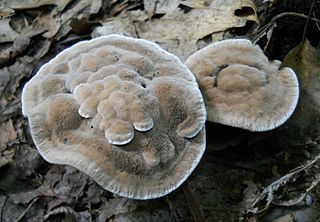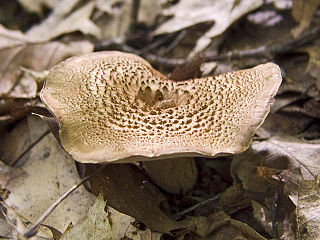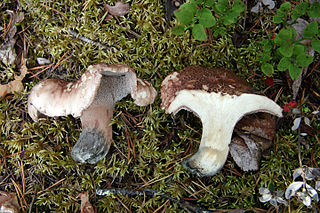
Hydnellum is a genus of tooth fungi in the family Bankeraceae. Widely distributed in the Northern Hemisphere, the genus contains around 40 species. The fruitbodies of its members grow by slowly enveloping nearby bits of grass and vegetation. There is great variability in the form of Hydnellum fruitbodies, which are greatly influenced by environmental conditions such as rainfall and humidity, drying winds, and temperature. They are too tough and woody to eat comfortably. Several species have become the focus of increasing conservation concern following widespread declines in abundance.

Sarcodon is a genus of fungi in the family Bankeraceae, which is part of the order Thelephorales known for its almost universal ectomycorrhizal life style. The genus owes its name to the presence of teeth-like spines on the hymenophore, it is derived from ancient Greek; sarco = flesh and odon = tooth. This is why they are commonly called "tooth fungi", or "Hydnoid fungi".

Hydnellum ferrugineum, commonly known as the mealy tooth or the reddish-brown corky spine fungus, is a species of tooth fungus in the family Bankeraceae. A widely distributed species, it is found in north Africa, Asia, Europe, and North America. The fungus fruits on the ground singly or in clusters in conifer forest, usually in poor or sandy soil. Fruit bodies are somewhat top-shaped, measuring 3–10 cm (1–4 in) in diameter. Their velvety surfaces, initially white to pink, sometimes exude drops of red liquid. The lower surface of the fruit body features white to reddish-brown spines up to 6 mm long. Mature fruit bodies become dark reddish brown in color, and are then difficult to distinguish from other similar Hydnellum species. H. ferrugineum forms a mat of mycelia in the humus and upper soil where it grows. The presence of the fungus changes the characteristics of the soil, making it more podzolized.

Hydnellum geogenium is a species of tooth fungus in the family Bankeraceae. It was described as new to science in 1852 by Elias Magnus Fries. Howard James Banker transferred it to the genus Hydnellum in 1913. The fungus is found in Europe and North America, where it grows in coniferous woods. It is inedible. H. geogenium is considered endangered in Switzerland. Fruitbodies of the fungus contain a yellow pigment compound called geogenin.

Hydnellum fuscoindicum is a species of tooth fungus in the genus Hydnellum. It is found in the Pacific Northwest in moss around western hemlocks. It produces fruit bodies with a violet-black cap, violet flesh, and violet spines on the cap underside. The odor and taste are very farinaceous. The fungus was first described by Kenneth A. Harrison in 1964 as a species of Hydnum, then transferred to Sarcodon in 1967 by Rudolph Arnold Maas Geesteranus. He placed this species in section Violacei of Sarcodon, along with H. fuligineoviolaceum and H. joeides.

Hydnellum compactum is a tooth fungus in the family Bankeraceae. It is found in Europe, where it grows in deciduous forest, typically under beech. Fruit bodies of the fungus grow singly or in groups. They are top-shaped, with convex or flattened upper surfaces up to 10 cm (4 in) in diameter. The surface texture is initially felt-like before becoming pitted and rough in age. The stipe, roughly the same color as the cap, is solid and measures 2–4 cm (0.8–1.6 in) long by 1–3 cm (0.4–1.2 in) thick. On the fertile cap underside are white to purple-brown, curved spines up to 5 mm long. The color is whitish at first but gradually turns dark brown to blackish. Its spores measure 5.5–6 by 3.5–4.5 µm, and feature tubercles that sometimes have a sunken tip. It is considered endangered in Switzerland.

Hydnellum spongiosipes, commonly known as the velvet tooth, is a tooth fungus in the family Bankeraceae. It is found in Europe and North America. In Switzerland, it is considered a vulnerable species.

Hydnellum scrobiculatum, commonly known as the ridged tooth, is a tooth fungus in the family Bankeraceae. Widely distributed in the Northern Hemisphere, it is found in Asia, Europe, and North America.

Phellodon niger, commonly known as the black tooth, is a species of tooth fungus in the family Bankeraceae, and the type species of the genus Phellodon. It was originally described by Elias Magnus Fries in 1815 as a species of Hydnum. Petter Karsten included it as one of the original three species when he circumscribed Phellodon in 1881. The fungus is found in Europe and North America, although molecular studies suggest that the North American populations represent a similar but genetically distinct species.

Hydnellum underwoodii is an inedible species of tooth fungus in the family Bankeraceae. Found in North America, it was described as new to science in 1906 by American mycologist Howard James Banker. Its reddish-brown, convex to flattened cap measures 5–14 cm (2.0–5.5 in) in diameter. Reddish-brown, partially erect scales adorn the cap surface. Spines on the cap underside are 1–3 mm long; they are initially white, becoming brown with grayish tips in age. The oval to spherical spores are 6–7.5 by 5.5–6.5 µm. The fungus fruits singly or scattered, on the ground in coniferous forests.

Phellodon melaleucus, commonly known as the grey tooth, is a species of tooth fungus in the family Bankeraceae. It was originally described by Elias Magnus Fries in 1815 as a species of Hydnum. In 1881, Petter Karsten included it as one of the original three species in his newly circumscribed genus Phellodon. The fungus is widely distributed in Europe and North America, where it associates mycorrhizally with a wide range of host trees. It is considered vulnerable in Switzerland.

Hydnellum glaucopus is a species of tooth fungus in the family Bankeraceae. Found in Europe, it was described as new to science in 1969 by mycologists Rudolph Arnold Maas Geesteranus and John Axel Nannfeldt. Fruit bodies contain cyathane diterpenes called glaucopins that have anti-inflammatory activity in laboratory tests. It is considered vulnerable in Switzerland.
Hydnellum lundellii is a species of tooth fungus in the family Bankeraceae. Found in Europe, it was described as new to science in 1969 by mycologists Rudolph Arnold Maas Geesteranus and John Axel Nannfeldt.

Hydnellum fuligineoviolaceum is a species of tooth fungus in the family Bankeraceae. It was originally described in 1874 by Hungarian mycologist Károly Kalchbrenner as Hydnum fuligineoviolaceum, in Elias Fries's work Hymenomycetes europaei. Narcisse Théophile Patouillard transferred it to the genus Sarcodon in 1900. Sarcodon talpa, published by Rudolph Arnold Maas Geesteranus in 1967, is a synonym.

Hydnellum amygdaliolens is a species of tooth fungus in the family Bankeraceae. Found in the Iberian Peninsula, it was described as new to science in 2011. It smells strongly of bitter almonds. Its spores measure 5.25–6.5 by 4.5 μm.

Hydnellum martioflavum is a species of tooth fungus in the family Bankeraceae, found in Europe and North America.

Hydnellum joeides is a species of tooth fungus in the family Bankeraceae.

Hydnellum gracilipes is a species of tooth fungus in the family Bankeraceae. It was first described scientifically in 1886 by Petter Karsten, who called it Hydnum gracilipes. He transferred it to the genus Hydnellum in 1879. Fruit bodies of the fungus have a pinkish to reddish-brown colour, a delicate texture described as "felty or papery", and flimsy stipes. Its spores are roughly spherical with a diameter of no more than 5 µm. H. gracilipes is found in northern Europe, where it is mycorrhizal with pine. Collections made in Scotland have been found by lifting the dense ground cover of common heather, which the fungus seems to use to as support to compensate for its flimsy stipe.

Hydnellum versipelle is a species of tooth fungus in the family Bankeraceae. It was originally described by Elias Fries in 1861 as Hydnum versipelle. Taisiya Lvovna Nikolayeva transferred it to the genus Sarcodon in 1961. Hydnum crassum, published by Kenneth A. Harrison in 1961, is a synonym. The species is found in Europe and North America.

Hydnellum scabrosum, also called bitter tooth or bitter hedgehog, is a species of tooth fungus in the family Bankeraceae.



















